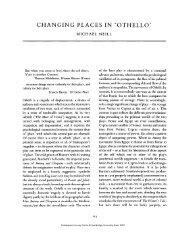the individualization of shakespeare's characters through imagery
the individualization of shakespeare's characters through imagery
the individualization of shakespeare's characters through imagery
You also want an ePaper? Increase the reach of your titles
YUMPU automatically turns print PDFs into web optimized ePapers that Google loves.
SHAKESPEARE SURVEY<br />
Hamlet speaks <strong>of</strong> <strong>the</strong> perfect man with enthusiasm. Yet he expresses this dream <strong>of</strong> his in<br />
concrete, substantial words. He does not say "what a miracle <strong>of</strong> nature is man" or "what a<br />
marvellous creation is man", as his words are usually translated into Russian, but: "what a piece<br />
<strong>of</strong> work is a man!" (n, ii, 323).<br />
Construction images occur several times in Hamlet's role* He calls <strong>the</strong> earth a "goodly frame"<br />
(n, ii, 317), <strong>the</strong> sky "this majestical ro<strong>of</strong> fretted with golden fire" (in <strong>the</strong> same monologue):<br />
precisely a ro<strong>of</strong>, and not a vault. O<strong>the</strong>r images <strong>of</strong> this class are as follows. Hamlet regrets that he<br />
is not made <strong>of</strong> pure metal (n, ii, 602). When Gertrude asks him to sit beside her he replies, indicating<br />
Ophelia: "Here's metal more attractive" (ni, ii, 117), i.e. a magnet. He tells Gertrude that<br />
his words will wring her heart "if it be made <strong>of</strong> penetrable stuff; if damned custom have not<br />
brazed it" (ni, iv, 36).<br />
Images which may be termed 'technical' are also to be found in Hamlet's role. "Adieu.<br />
Thine evermore, most dear lady, whilst this machine is to him, Hamlet", be writes to Ophelia<br />
(n, ii, 124). It is characteristic also that he calls <strong>the</strong> laws <strong>of</strong> thinking "<strong>the</strong> pales and forts<br />
<strong>of</strong> reason" (1, iv, 28). "For 'tis <strong>the</strong> sport", he says, referring to his enemies Rosencrantz and<br />
Guildenstern, "to have <strong>the</strong> engineer hoist with his own petar" (ni, iv, 206), adding that he "will<br />
delve one yard below <strong>the</strong>ir mines." We repeat: Hamlet's <strong>imagery</strong> is for <strong>the</strong> most part substantially<br />
concrete. He compares virtue with wax that melts in <strong>the</strong> fire <strong>of</strong> "flaming youth" (in, iv, 84).<br />
He calls his own head a "distracted globe" (1, v, 97). He compares <strong>the</strong> cracked voice <strong>of</strong> a boy<br />
actor playing female roles to a cracked gold piece unfit for circulation (n, ii, 446). According to<br />
him, if he had killed Claudius while <strong>the</strong> latter was praying it would have been "hire and salary,<br />
not revenge" (in, iii, 79). He does not say "who would bear life's adversities", but "who would<br />
fardels bear, to grunt and sweat under a weary life" (in, i, 76). He does not say that art ought to<br />
copy nature, but that art should "hold, as 'twere, <strong>the</strong> mirror up to nature" (in, ii, 26), i.e. again<br />
makes use <strong>of</strong> a definite object to give expression to his thoughts. Hamlet tells Gertrude that he<br />
will "set you up a glass" (in, iv, 19). He compares <strong>the</strong> air and <strong>the</strong> sky to a canopy (m, ii, 298).<br />
In his words, Fortinbras' soldiers are ready to "go to <strong>the</strong>ir graves like beds" (iv, iv, 62). He does<br />
not say "<strong>the</strong> external expressions <strong>of</strong> woe", but "<strong>the</strong> trappings and <strong>the</strong> suits <strong>of</strong> woe" (1, ii, 86).<br />
He resorts to definite objects even to express his most hidden and complex feelings and ideas. He<br />
could have been, he says, "bounded in a nut-shell, and count myself a king <strong>of</strong> infinite space"<br />
(n, ii, 264). He likens his soul to a pipe which Rosencrantz and Guildenstern try to play with<br />
clumsy fingers (in, ii, 354). He calls death "<strong>the</strong> undiscover'd country, from whose bourn no<br />
traveller returns" (ni, i, 79), an image typical <strong>of</strong> an age <strong>of</strong> geographical discoveries, when many<br />
set out across <strong>the</strong> seas in ships in search <strong>of</strong> new lands and treasures and frequently failed to return.<br />
Dying, Hamlet declares that "this fell sergeant, death, is strict in his arrest" (v, ii, 325). All <strong>the</strong>se<br />
images are concrete, substantial. Typical <strong>of</strong> <strong>the</strong> tangible substantiality <strong>of</strong> Hamlet's style is <strong>the</strong><br />
fact that looking at Yorick's skull, he does not say "here is where <strong>the</strong> lips were", but "here<br />
hung those lips" (v, i, 177).<br />
Among Hamlet's images is a definite set relating to nature and to gardening and agriculture.<br />
"O, that this too, too solid flesh would melt, thaw, and resolve itself into a dew!" he cries<br />
(1, ii, 129). The world is "an unweeded garden that grows to seed" (1, ii, 135). He compares <strong>the</strong><br />
earth to "a sterile promontory" (11, ii, 297), again a realistic image. His fa<strong>the</strong>r died unshriven,<br />
"his crimes broad blown as flush as May" (in, iii, 81). He asks his mo<strong>the</strong>r not to "spread <strong>the</strong><br />
94<br />
Shakespeare Survey Online © Cambridge University Press, 2007



